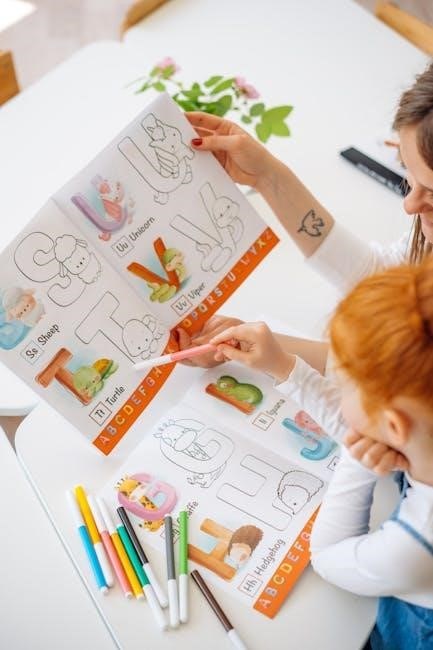A parent-teacher conference form is a structured template designed to document a student’s progress․ It highlights strengths, areas for growth, and creates action plans․ This tool ensures effective communication between educators and guardians, fostering collaboration and supporting student success․
Importance of Parent-Teacher Conferences
Parent-teacher conferences are vital for fostering collaboration between educators and guardians․ They provide a platform to discuss a student’s academic performance, social development, and emotional well-being․ Regular meetings ensure that both parties are aligned on goals, helping students achieve their full potential․ These conversations also allow teachers to share insights and strategies, enabling parents to support their child’s learning at home․ By maintaining open communication, conferences help address challenges early, promote positive behavior, and create a supportive learning environment․ Ultimately, they play a key role in fostering student success and strengthening the partnership between schools and families․
What is a Parent-Teacher Conference Form?
A parent-teacher conference form is a structured document used to guide and document discussions during meetings between educators and parents․ It typically includes sections for student information, academic performance, strengths, areas for improvement, and action plans․ This form ensures that conferences are organized, focused, and productive․ It serves as a reference tool for both teachers and parents, providing a clear record of the discussion and agreed-upon steps․ By using a standardized format, the form helps maintain consistency and clarity, making it easier to track a student’s progress over time․ Its flexibility allows customization to meet specific needs, ensuring it remains a valuable resource for fostering effective communication and collaboration․

Sections of a Parent-Teacher Conference Form
A parent-teacher conference form typically includes sections for student information, academic performance, strengths, areas for growth, and behavioral observations, ensuring a comprehensive overview of a student’s progress․
Student Information
The Student Information section of a parent-teacher conference form typically includes essential details such as the student’s name, grade level, and teacher’s name․ It may also list the date of the conference and the parent/guardian’s contact information․ This section ensures that all parties involved are aware of the student’s basic details, facilitating clear communication․ It also helps in maintaining accurate records for future reference․ By including this information, the form provides a structured starting point for discussions, ensuring that the conference remains focused and relevant to the student’s specific needs․ This section is crucial for organizing and personalizing the feedback shared during the meeting․
Strengths and Areas for Growth
This section of the parent-teacher conference form focuses on documenting a student’s strengths and identifying areas for growth․ It provides a clear overview of the student’s performance, highlighting positive attributes such as academic skills, social interactions, and personal qualities․ Teachers can note specific achievements or talents, while also addressing challenges the student may face․ This section encourages a balanced discussion, allowing parents and educators to acknowledge successes and collaboratively develop strategies for improvement․ By outlining both strengths and areas needing support, the form helps create a comprehensive understanding of the student’s overall development․ This structured approach ensures that the conference remains focused on fostering growth and success․
Academic Performance and Assessment Data

This section of the parent-teacher conference form focuses on documenting a student’s academic performance and assessment data․ It includes details such as grades, test scores, and progress in specific subjects․ Teachers can highlight achievements in core areas like reading, math, and science, while also noting challenges or areas where the student may need additional support․ The form often includes space for specific examples of the student’s work and any standardized test results; This data helps parents and educators track progress over time and identify patterns in learning․ By providing a clear and concise overview, this section supports informed discussions about the student’s academic journey and future goals․ It ensures that both parents and teachers are aligned on the student’s current standing and next steps․
Behavior and Social Skills
This section of the parent-teacher conference form focuses on documenting a student’s behavior and social skills․ It includes observations about the student’s ability to cooperate with peers, respect classroom rules, and demonstrate responsibility․ Teachers may note specific behaviors such as leadership, teamwork, or communication skills․ Additionally, this section highlights any challenges the student may face, such as difficulty sharing, following directions, or managing emotions․ By providing detailed insights, this part of the form helps parents and educators understand the student’s social and emotional development․ It also serves as a foundation for discussing strategies to support positive behavior and improve social interactions․ This information is crucial for fostering a well-rounded educational experience․
Templates and Examples
Explore templates and examples tailored for parent-teacher conferences․ These resources offer structured forms to document student progress and facilitate productive discussions․ They are designed to streamline the documentation process and ensure effective communication between educators and parents․ With customizable options, schools can adapt these templates to meet specific needs, making them versatile tools for fostering student success․
Available Templates for Parent-Teacher Conferences
Various templates are available to facilitate parent-teacher conferences, offering structured formats to document student progress․ These include customizable PDF forms, Word documents, and online templates․ Many schools and educational platforms provide these resources to ensure effective communication and organization․ Templates often include sections for student strengths, areas for growth, academic performance, and social skills․ They also allow for action plans and follow-up meeting details․ Educators can adapt these templates to suit specific needs, making them versatile tools for conferences․ Online platforms further simplify the process by offering editable and printable versions, ensuring efficiency and thorough documentation for both teachers and parents․ These resources are widely accessible and designed to support student success․

Customizable PDF Forms for Schools
Customizable PDF forms are versatile tools for schools to streamline parent-teacher conferences․ These templates allow educators to tailor content to specific student needs, ensuring detailed and relevant documentation․ With features like editable fields and digital signatures, PDF forms simplify the process of gathering and sharing information․ Schools can easily adapt these forms to align with their policies and branding, creating a professional and consistent appearance․ Many platforms offer free or affordable templates that are accessible online, making it easy for teachers to download, modify, and print them․ This format is ideal for maintaining organization and ensuring that all critical discussion points are captured effectively during conferences․ Additionally, PDF forms can be shared digitally, promoting efficiency and reducing paperwork․

Benefits of Using a Parent-Teacher Conference Form
Parent-teacher conference forms enhance communication and organization, ensuring all topics are covered․ They streamline documentation, making it easier for teachers to prepare and track progress, leading to more productive discussions․
Improved Communication Between Teachers and Parents
Parent-teacher conference forms play a crucial role in enhancing communication between educators and guardians․ By providing a structured format, these forms ensure that discussions are focused and productive․ Teachers can clearly outline a student’s strengths, areas for growth, and specific goals, while parents can share their observations and concerns․ The form acts as a guide, helping both parties stay on topic and address key issues․ This organized approach fosters mutual understanding and collaboration, ensuring everyone is aligned in supporting the student’s development․ With a clear record of the discussion, both teachers and parents can refer back to the form for follow-up and accountability․
Streamlined Documentation Process
Parent-teacher conference forms simplify the documentation process, saving time and reducing administrative tasks․ By using a standardized template, teachers can quickly and efficiently record key discussion points, action items, and follow-up steps․ This ensures that all important details are captured in a single document, eliminating the need for multiple notes or spreadsheets․ The form also serves as a permanent record, providing a clear reference for future meetings or progress tracking․ With a streamlined process, educators can focus more on meaningful conversations and less on paperwork, making conferences more productive and impactful for both teachers and parents․


How to Use the Form Effectively
Review the form beforehand, noting key points to discuss․ Use it to guide the conversation, ensuring clarity and focus․ Document decisions and follow-up actions clearly for future reference․
Preparing for the Conference
To ensure a productive meeting, review the parent-teacher conference form beforehand․ Identify the student’s strengths and areas for growth to discuss․ Gather recent academic and behavioral data, such as grades, test scores, and observation notes․ Highlight specific concerns or successes to address during the conversation․ Consider questions or topics parents may want to discuss and prepare thoughtful responses․ Organize the form to prioritize key points, ensuring a focused and efficient dialogue; Finally, plan for follow-up actions or next steps, assigning responsibilities as needed․ Clear preparation fosters effective communication and collaboration between educators and parents․

Documenting Key Discussion Points
Accurately documenting key discussion points during a parent-teacher conference ensures clarity and follow-through․ Use the parent-teacher conference form to summarize decisions, action items, and agreed-upon steps․ Include specific examples of the student’s strengths and areas for growth, as well as any support or enrichment recommendations․ Note any follow-up meetings or deadlines, and assign responsibilities to both the teacher and parent․ This documentation serves as a reference for future progress monitoring and ensures accountability․ By organizing the discussion points clearly, the form helps maintain a focused and productive conversation, ultimately supporting the student’s success․ Clear documentation also fosters better collaboration between educators and parents․

Digital Solutions for Parent-Teacher Conferences
Digital solutions simplify parent-teacher conferences with online forms and e-signatures․ Schools can use customizable PDF templates to collect data efficiently, ensuring accessibility and streamlining the process․
Online Forms and E-Signatures
Online forms and e-signatures streamline parent-teacher conference processes, enabling seamless communication and documentation․ These digital tools allow schools to create customizable PDF templates, ensuring all necessary information is collected efficiently․ Parents and teachers can access forms from any device, reducing paperwork and saving time․ E-signatures also simplify the approval process, making it easier to finalize agreements or action plans․ Additionally, online forms can be integrated with school management systems, ensuring data is organized and readily accessible․ This approach not only enhances convenience but also improves the overall efficiency of parent-teacher conferences, fostering better collaboration and student support․ Security features ensure confidentiality, making digital solutions a reliable choice for schools․
Templates for Follow-Up Meetings
Templates for follow-up meetings are essential for maintaining consistent communication after parent-teacher conferences․ These templates help track student progress, document discussions, and outline actionable steps․ They ensure that agreements and goals set during initial meetings are revisited and evaluated․ By using structured follow-up templates, teachers can efficiently monitor student improvements and address any ongoing concerns․ These tools also provide a clear record of communication, helping parents and educators stay aligned․ Follow-up templates save time and ensure that meetings are productive, fostering a collaborative approach to student development and support․ They are customizable to suit individual student needs, making them a valuable resource for continuous engagement․

Legal and Ethical Considerations
Parent-teacher conference forms must adhere to confidentiality and data protection laws, ensuring all shared information remains secure and compliant with ethical standards․
Confidentiality and Data Protection
Ensuring confidentiality is crucial when handling student information in parent-teacher conference forms․ Schools must comply with data protection laws, such as FERPA, to safeguard sensitive details․ Access to forms should be restricted to authorized personnel, and digital platforms must use encryption to prevent unauthorized access․ Parents should be informed about how their child’s data is stored and shared․ Breaches in confidentiality can lead to legal consequences, making it essential to implement robust security measures․ By maintaining confidentiality, schools build trust with families and protect students’ privacy․
Ensuring Compliance with School Policies
Parent-teacher conference forms must align with school policies to ensure consistency and fairness; Schools often require forms to be approved by administrators before use․ Standardized templates help maintain uniformity in documenting student progress and concerns․ Policies may also dictate how forms are shared with parents, ensuring accessibility and clarity; Training for staff on proper form usage is essential to avoid deviations from school guidelines․ Regular reviews of forms by school leadership help verify compliance and address any discrepancies․ By adhering to these policies, schools maintain professionalism and ensure that conferences remain focused on student well-being and academic growth․
Parent-teacher conference forms are essential tools for fostering collaboration and tracking student progress․ They ensure organized communication, aiding in tailored support for each student’s academic and personal growth․
Final Thoughts on the Importance of Parent-Teacher Conference Forms
Parent-teacher conference forms play a pivotal role in fostering effective communication and collaboration between educators and parents․ These documents provide a structured framework to discuss a student’s strengths, areas for growth, and academic performance․ By documenting key points, they ensure accountability and continuity in supporting student progress․ Additionally, these forms offer a personalized approach to address individual needs, making them invaluable for both teachers and families․ Their adaptability to various educational settings and ease of customization make them a practical solution for schools․ Ultimately, parent-teacher conference forms are not just tools for documentation but catalysts for meaningful engagement and student success․





